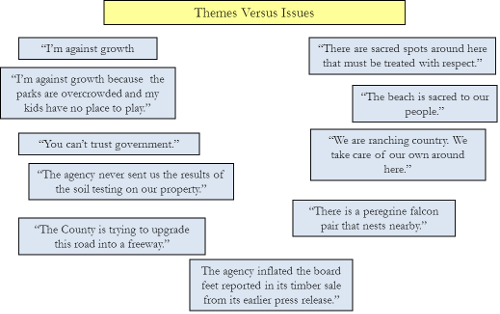
The key to resolving issues through the issue management process is to distinguish between issues and themes and to ground these issues in real people. CSEPP refers to this process as a grounded response.Themes are the views or observations by people about their community. Themes do not carry a demand, but instead reflect attitudes, beliefs, values, and customs. Themes cannot be acted upon. Issues, on the other hand, express a requirement or demand and are action oriented. Issues can be acted upon and resolved through appropriate strategies and mitigation measures. Issues are carried by various people within a community. The table below shows the difference between themes, issues, and the people carrying the issues for the Warm Springs Specific Plan process.
Issues are owned by people with faces, names, addresses, telephone numbers, traditions and interests. Issues must be grounded, that is people who carry issues must be identified and those people must be able to stay in touch with their issue through the life of that issue. If names or faces cannot be linked with the issues affecting a policy or project, then effective action cannot be taken on those issues. Grounded responses to issues comes from the ability to:
- Identify people who carry the issue.
- Maintain the identity of people who carry the issue throughout the life of the issue.
- Identify the subjects of interest upon which action can be taken.
- Understand the cultural description of the community.
- Establish direct communication with the networks.
- Probe the issue for the WHO, WHAT and WHY.
After issues have been grounded, the next step is to verify the issues with the informal networks and begin to identify opportunities and strategies to address the issues. The key to success in grounding responses is to turn issue carriers into issue resolvers by keeping those people actively involved in the issue management process.
Examples of themes versus issues
The following table compares themes versus issues associated with a long-term plan CSEPP helped develop for the Warm Springs area near Reno, NV. (You can read a full discussion of CSEPP’s approach to issue management as applied to this case in the Issue Management Handbook.)
| Themes | Issues |
|---|---|
| “We are a rural community.” | The ability to have 4H animals on a residential lot. |
| “We want to maintain our rural lifestyle.” | Retaining gravel roads so horse riders can move around the community |
| “We don’t want any lots smaller than 40 acres.” | Making sure that there are no lots smaller than 10 acres in size next to existing 40 acre lots. |
| “No one will drive out this far to buy third acre lots.” | Keeping lots larger than one acre so horses and 4H animals can be kept on the lot. |
| “We don’t want traffic from the specific plan area driving on our roads.” | Making sure that current residents will not have to pay more taxes to maintain their roads. |
| “People from the specific plan area will use our roads as short cuts.” | Ensuring that specific plan area residents will pay the full cost of building roads inside the specific plan area. |

